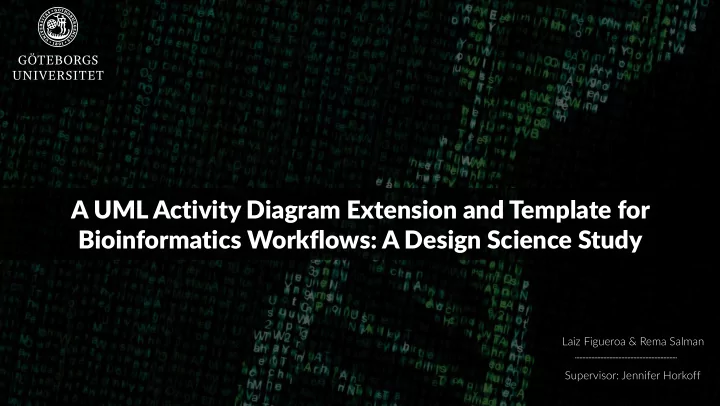

A UML Activity Diagram Extension and Template for Bioinformatics Workflows: A Design Science Study Laiz Figueroa & Rema Salman Supervisor: Jennifer Horkoff
Introduction Workflow Bioinformatics & Usage Pipeline These workflows need to • Biology and computational • Sequence of tasks from • be followed precisely to methods together [1] initialisation to producing generate the correct data final results [2] [4] • Uses several tools to generate data • Shepherding files through a series of transformations • Tools’ connections are [3] represented by workflows (pipelines) �2
Problem [9] [11] [10] Quality assessment of the sequence reads was performed by generating QC statistics with FastQC (http://www.bioinformatics.bbsrc.ac.uk/projects/fastqc). Read alignment to the reference human genome (hg19,UCSC assembly, February 2009) was done using BWA (1) with default parameters. [A summary of the sequencing data is shown in Table X.] After removal of PCR duplicates (Picard tools, http://picard.sourceforge.net) and file conversion (samtools (2)) quality score recalibration, indel realignment and variant calling were performed with the GATK package(3). Variants were annotated with Annovar (4) using a wide range of databases such as dbSNP build 135 (5), dbNSFP (6), KEGG (7), the Gene Ontology project (8), MITOMAP (9) and tracks from the UCSC. [11] �3 [11]
Background Horkoff et al. [8] • Used several modelling languages • UML activity diagram most suitable • Identified concepts gaps • Motivations • Sources • Thresholds • Files • Suggested further study to extend the language • Proposed a draft for workflow elicitation �4
Research Question How can we extend the UML activity diagram and use a template for workflow documentation to understand and improve bioinformatics workflows? �5
Research Purpose Extend the UML AD meta-model, create its new concrete syntax, and generate a Workflow Documentation Specification Template (WDST) Increase efficiency to manage workflows Establish a shared understanding and consistency between the activities Create a sharable documentation set Provide a way to train new bioinformaticians Identify problems in workflows �6
Facilities & Sample Bioinformatics Core Facility 6 Genomic Medicine Sweden Purposive sampling technique The head of CRITERIA Bioinformatics Core Bioinformaticians with Translational Genomics Platform Facility workflows’ knowledge �7
Methodology Recorded semi-structured interview 1 st 5 bioinformaticians Transcript using Temi Thematic analysis Recorded semi-structured interview intercalated with artefacts’ test 2 nd 5 bioinformaticians - 1 new Think aloud protocol - log Transcript using Temi Thematic analysis Recorded workshop discussion 6 bioinformaticians - 1 new 3 rd Validation questions using Mentimeter Transcript using Temi Thematic analysis Suggest further studies �8
UML Activity Diagram Extension Meta-model RQ 1.1 What are the defining and unique characteristics of bioinformatics workflows compared to standard workflows? 9 highly used characteristics 3 considered unique 6 bridge between standard workflow and UML AD data flow behaviour to AD Added �9
1 Name Base Class Description Notation Concrete Syntax An iterative set of activities and actions represents Loop ActivityEdge until reaching the defined condition. Represent an outcome of a test based on a condition SoftCondition ActivityEdge with a limited soft-threshold value. The condition is RQ 1.2 predefined guards on the outgoing edges. Represent an outcome of a test based on a condition HardCondition ActivityEdge with a limited hard-threshold value. The condition is How should workflows, including the concepts discovered in RQ1.1 be predefined guards on the outgoing edges. visualised to be understandable by the bioinformaticians? Sub-processConnector Used to connect the sub-processes parts within the same ActivityEdge diagram. A connector used between the dark input and the StandardReferenceConnector Activity Edge multiple documents notations to represent the standard reference. 4.3 Use the Data that is used to make comparison. This data is StandardReference ObjectNode normally standards followed. For example, human Understandable genome. concrete syntax 3.7 with Easy to use A labeled triangle that represents the connection point DiagramSeparator ObjectNode with an other part of the diagram from other page. labels 3.0 Likelihood of use A link, document title, person’s name which are the Source ObjectNode source or responsible for a specific set of actions. 2.8 A tool or software used to perform an activity with a ObjectNode description of the activity. That is automated operated. Stakeholders understandability Tool A tool or software used to perform an activity with a ObjectNode description of the activity. That is manually operated. �10 A structured set of data that is accessible in various Database DataStoreNode ways.
Recommend
More recommend